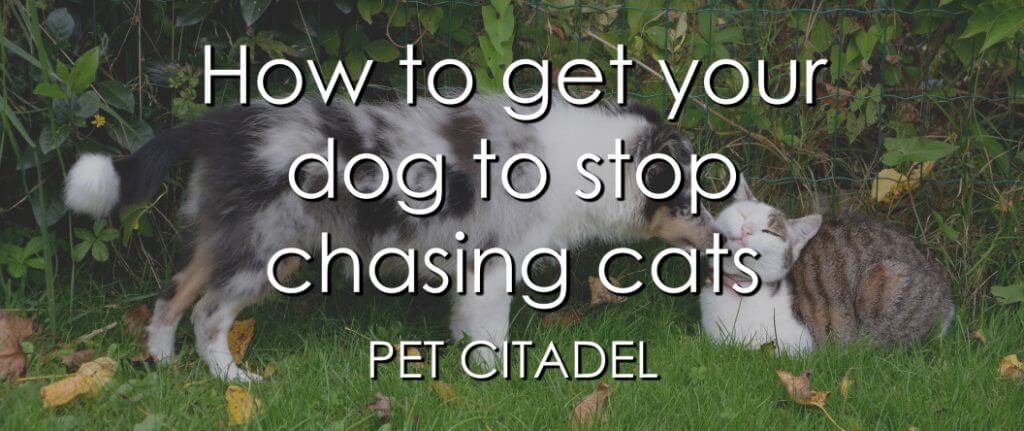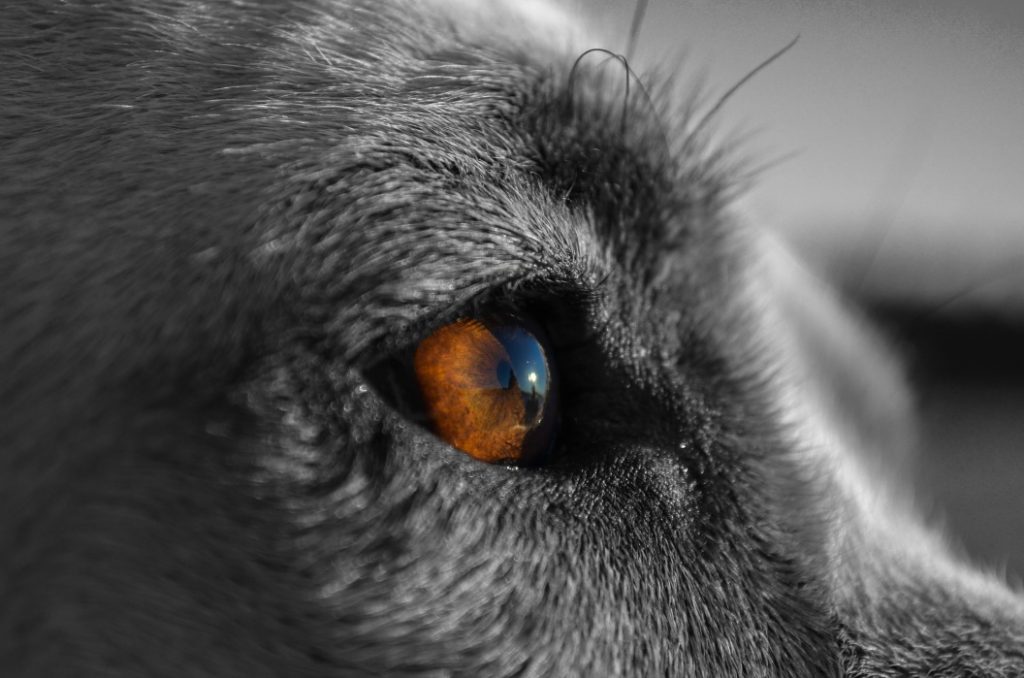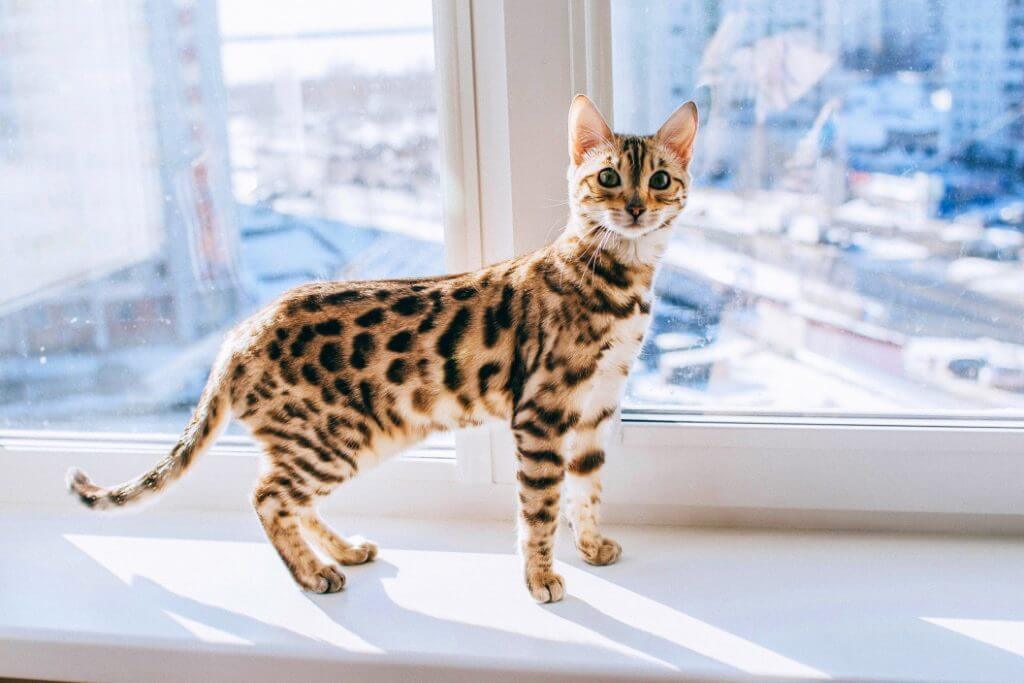This post may contain affiliate links. You can view our affiliate disclosure here.

Dogs instinctively have a tendency to chase what they consider to be prey. They have passed this down from the days of their wolf ancestors.
Over the years, man has capitalized on this with certain breeds; for example, they used terrier breeds to chase rats.
Certain dog breeds are more prone to chase cats than others, and dogs that are brought up with cats will also have a reduced drive to chase them.
When considering this issue, it is important to differentiate a mutual play where the cat and the dog are both willing partners in a game, from other forms of chasing. Dogs may also cooperate with your pet cat in defending their joint territory from other cats that may intrude.
In this article, we’ll go over the best approaches for getting your dog to stop chasing cats, whether your own cats or other unfamiliar cats.
Initial Considerations
Dogs are predators by nature. If a dog sees potential prey such as a rat, squirrel, or cat, and it runs, then it will instinctively give chase and may become fixated. If the prey keeps running, eventually the dog will catch it and “bring it down”.

However, if the cat were to stop and attack or threaten the dog, often the dog will slink away, as the exciting chase is over, and all that is left is the potential to get hurt.
In the wild, this behavior is normal and acceptable. However, we live in a society where cats roam free and the cat owner has an expectation that their cat will not be savaged to death by an aggressive dog.
So, it’s not really the behavior that is wrong, but rather the dog’s failure to fit into the expectations of our society that is the problem.
So, dog owners have to teach their dogs that chasing, and especially attacking, cats or other animals is not permitted.
How To Stop The Chasing
One of the reasons that dogs have coexisted alongside humans for so long is that dogs generally are very good at obeying and taking instructions. A dog wants to please its human owner and it is just a matter of making the dog understand what is required.
Taking this approach, we create a situation where the dog modifies its own behavior because it wants to please you.
General Dog Training
The best solution is to have a limited vocabulary of instructions that the dog understands and will obey, whatever the circumstances. This includes when it chases cats or barks at them.
Three particularly important commands are “leave”, “stay”, and “down” or variations with the same effect.
You can use these instructions when your dog shows signs that it is about to chase a cat (and in countless other situations). In this way, you automatically solve the “how to stop my dog from chasing cats” issue.
Clicker Training
One very effective way to train a dog is through the use of a clicker. You can purchase clickers from many pet stores.
The clicker should reinforce good behavior and not be used when the dog chases the cat.
Instead, use the clicker when the dog refrains from chasing the cat. Once the dog has associated the click with good behavior and comes to you, give the dog a treat as a reward.
So first, the dog learns to associate the clicking sound with “hey, I’ve done something good!”, and then if it hears the clicking sound, it can come to you and expect a treat, thus leaving the cat alone.
It will take your dog a little time to realize that chasing the cat is not good, so you must reward even partial success. If the dog chases the cat and then stops, use the clicker.
Adding A Cat To The Household
When you first introduce a new cat or kitten to the household, do it in controlled conditions.
Ideally, bring the cat or kitten into an empty room in a cat cage, and then let the dog into the room. The dog will immediately notice the cat and start to circle and sniff at the cage, exploring exactly what is there.
The cat will be unable to run and will just sit there. Eventually, the dog will become bored and just ignore the cat.

If you had introduced them without the cat cage, the cat no doubt would have run when it saw the dog, and you have immediately created a new, potentially dangerous game for the dog.
Throughout the early meetings, you should make sure they are always in controlled conditions where the cat is stopped from running and the dog is stopped from chasing. Eventually, both the cat and the dog will become less responsive to the other.
To a young dog, chasing a cat can be a very fun activity. You need to convince the dog that not chasing the cat is even more rewarding.
After you have introduced the dog and cat, you can let them loose in the same room. Every time the cat moves or attracts the attention of the dog, you should intervene by providing a tasty treat and/or by giving your dog attention.
Overcome the dog’s natural instinct and make it more fun to hang around with you instead.
Other Factors
You should think about why the dog is chasing the cat in the first place. Is it trying to bite or harm the cat, or is it just a matter of wanting to play?
If it’s a matter of play, then perhaps the dog is not getting enough walks or exercise and is using its surplus energy to chase the cat.
It is very important that your dog sees the cat as a companion and not as a toy to chase. Early training is essential to instill this in the dog’s mind.
Negative Association
If you have tried these methods of controlling your dog’s behaviour and you still haven’t convinced it that chasing cats is a bad idea, then you need to consider ways of, harmlessly, making your dog associate chasing cats with an unpleasant experience.
You could consider keeping a water spray bottle handy, filled with a lemon and water mixture. When the dog chases the cat, spray it.
Eventually, the dog will realize that chasing a cat leads to getting a horrible-smelling liquid sprayed at it.
Other forms of deterrent work equally well, as long as the dog associates the (harmless) punishment with the cat chasing activity.
Here are 5 smells that dogs dislike and that you can use to your advantage:
Conclusion
It’s worth noting that it’s very possible for dogs and cats to live quite amicably side by side. In this way, they walk around each other, greet each other, and if another cat threatens the family cat, the dog will intervene to protect its friend.
Remember: this is a two-way relationship, and if the cat insists on running whenever the dog is present, then the dog will assume it is supposed to give chase.
Working with the cat can be as important as training the dog if a happy coexistence is to be established.
However, there may be situations where you can’t get your dog to stop chasing. It might have a prey drive that is too strong, or it might be suffering from more serious issues that you can’t address by yourself.
If you’re really having a hard time training your dog not to chase cats, or you’re simply having problems getting your dog to come when called, you could get the help of a dog trainer. But professional dog trainers and behaviourists can be extremely expensive – something like $500 for 3 hours, or even more.
Who’s going to pay this amount of money for just 2 or 3 hours of help?
There’s a solution. You can get instant access to a dog training program by a certified dog trainer with over a decade of experience working with clients.
This trainer has figured out that poor recall response from dogs fundamentally comes down to learning how to calm your dog down so it can regain control of its emotions.
And so he’s put together a series of emotional control exercises that have been proven to get your dog to listen to you instead of chasing cats.
This dog training package is substantial, and it costs a tiny fraction of what you would pay for the services of a typical dog trainer.
You can alternatively read my review of the program. Good luck!
Thanks for reading this article. Do you have problems with your dog chasing cats? Feel free to share your experiences or ask questions in the comments below.




